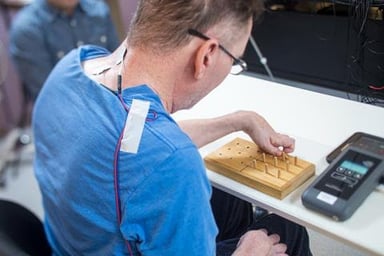Reeve Foundation's Scientific Advisory Board: Chet Moritz, Ph.D.
Join Our Movement
What started as an idea has become a national movement. With your support, we can influence policy and inspire lasting change.
Become an Advocate
In Dr. Moritz’s lab alone, researchers have learned that combining transcutaneous stimulation devices with occupational therapy of the hands and arms — including many repetitions of functional tasks — substantially improves hand function among people with SCI. What’s more, after 10 to 24 such practice sessions, people continued to experience the benefits of improved motor function, even when the device was turned off.
“That was the watershed moment for us when we realized that transcutaneous stimulation combined with occupational therapy might allow people to recover enough function to return to their hobbies more than a decade after their injuries,” Dr. Moritz says. “Some of our participants were even able to resume activities that require a lot of fine motor skill like playing the electric guitar or oil painting. This led directly to the ONWARD Up-LIFT study, the first large-scale pivotal trial of non-invasive spinal cord stimulation technology.”
According to Dr. Moritz, this work is just one example of the magic that happens when scientists combine tools from diverse fields — from neuroscience and engineering to cell biology and physical therapy — to advance treatments for spinal cord injury. Ultimately, the hope for people with SCI is that neural prostheses will become what pacemakers are for people with heart disease: a seamless device that dramatically improves their quality and quantity of life.
Dr. Moritz is part of our newly launched Christopher & Dana Reeve Foundation Scientific Advisory Board. It is comprised of senior and junior investigators from across the globe and in numerous scientific sectors and serves as a sounding board for the Foundation, offering innovative ideas and honest feedback as we search for the most promising research and development opportunities that will provide the greatest impact for community members.
Photo Credit: Matt Hagen
.jpg?width=211&height=317&name=Chet%20Moritz_Portrait_0040-Hi%20Res%20(1).jpg) “Starting in about 3rd grade, I had a lot of exposure to kids who used wheelchairs for various reasons,” says Dr. Moritz, Ph.D. Hwang Endowed Professor, University of Washington Departments of Electrical & Computer Engineering, Rehabilitation Medicine, and Physiology & Biophysics. “I’d always felt this desire to help them in some way — not to walk again, but rather a sort of kinship that fed my interest in health sciences.”
“Starting in about 3rd grade, I had a lot of exposure to kids who used wheelchairs for various reasons,” says Dr. Moritz, Ph.D. Hwang Endowed Professor, University of Washington Departments of Electrical & Computer Engineering, Rehabilitation Medicine, and Physiology & Biophysics. “I’d always felt this desire to help them in some way — not to walk again, but rather a sort of kinship that fed my interest in health sciences.”
